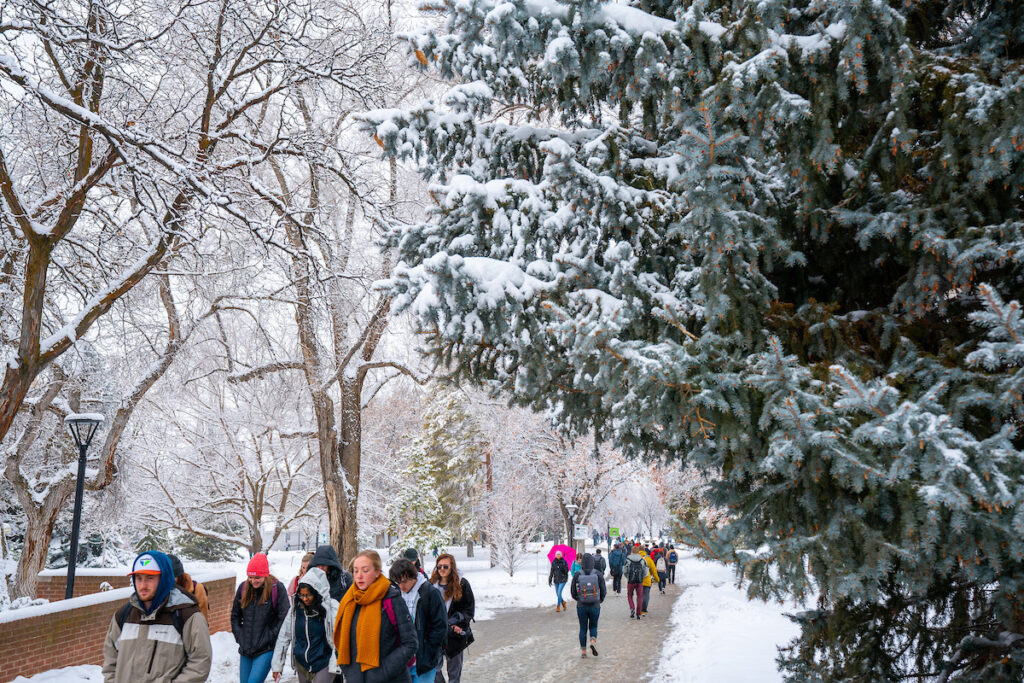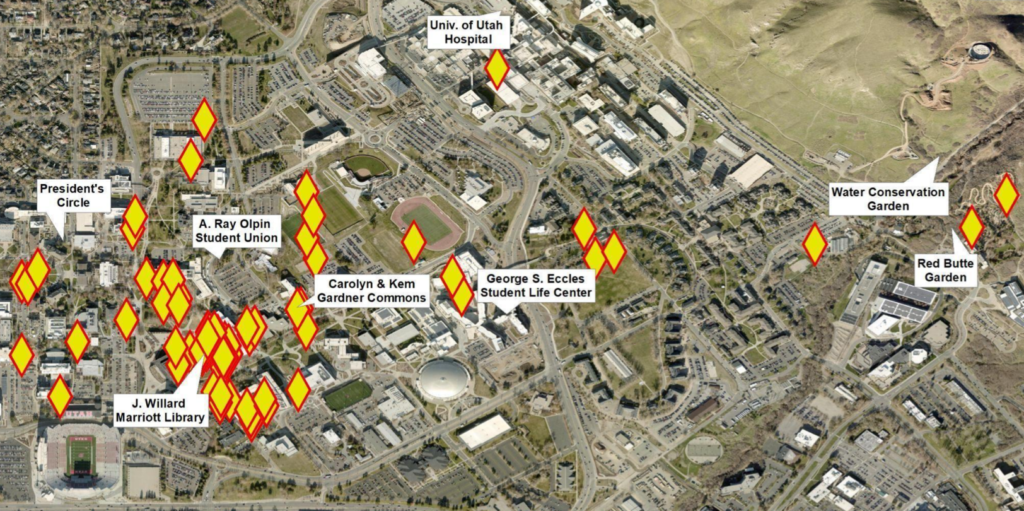Living Labs are a growing model for collaborative sustainability innovation across disciplines and sectors. In this model, academic researchers and other experts collaborate with communities and institutions to develop and test new approaches and create locally-adaptive solutions.
The Living Lab model provides a multitude of benefits, including building community relationships and aligning the goals of multiple groups to achieve creative solutions more quickly and inclusively.
In Global Changes and Society 2023, we focused on the University of Utah campus as a Living Lab. Students met with campus staff and faculty who are working on campus sustainability and developed projects that were responsive to current questions, needs and opportunities within university operations and campus life.
-
Page 5 of the guide (pictured at right) will allow you to navigate through the document.There are so many sustainability-related programs and initiatives at the U that it can be hard to keep track - especially as sustainability becomes a key part of every department on campus, not just the Sustainability Office. This guide is a collection of resources from across the University of Utah related to sustainability - from ongoing projects to academic courses to funding opportunities. It is intended to be just as helpful for the graduate student dedicating their career to sustainability as it is for the first-year student who doesn't know anything about sustainability.
 Click to open the interactive Sustainability Guide.
Click to open the interactive Sustainability Guide.
-
Students researched the problem of flooding in the Edible Campus Garden, and developed a proposal to install green infrastructure to mitigate the deleterious effects of stormwater runoff and improve the garden ecosystem.Click here to learn more about this proposed green infrastructure solution.The Sustainable Campus Initiative Fund at the University of Utah has the opportunity to make a student-initiated project economically feasible while solving an existing problem on campus. This project involves installing a bioswale to mitigate flooding issues at the Edible Campus Garden. The primary focus is to improve the productivity and functionality of the Edible Campus Garden but the project will also provide notable environmental, ecological, and social benefits. The primary function of a bioswale is to filter runoff through biofiltration of above ground vegetation and bioretention achieved by an application of engineered soil above the native soil. A high degree of effectiveness has been noted for retention and removal of oil and grease in runoff that is retained in bioswales. Bioswales are also effective to a lesser extent for mitigating sediment, nutrient, metal, and bacteria pollution in runoff.1 In addition to improving garden productivity and operations, this project will provide other valuable benefits. An improved water catchment design will replace a rudimentary trench the garden staff and volunteers dug out of necessity in the fall of 2022 that has raised safety concerns for pedestrians. This project also presents educational opportunities by way of signage along the walkway and/or near the public benches and picnic tables in the garden. Lastly, retaining rainwater in close proximity to the planting rows is very likely to reduce the irrigation demands from that portion of the garden. Managers of the campus garden have the potential to utilize the bioswale for plants that benefit from the moisture laden growing conditions of the green infrastructure design.

https://www.researchgate.net/figure/Layers-and-moisture-zones-of-a-rain-garden-Modified-from-Yuan-and-Dunnet-2018_fig5_354859712 -
For this project, students examined complete streets case studies from different cities and universities. They also interviewed Salt Lake City Transportation Division representatives to understand more about campus area streets. Learn more about complete streets, the above-mentioned case studies, and some suggestions that the University might consider in campus planning and design for a growing population.Complete Streets are an approach to designing streets that prioritize safety, accessibility, and sustainability for all users. Our team has researched the concept of Complete Streets and analyzed its application within the University of Utah campus. The university is experiencing rapid growth and aims to reduce greenhouse gas emissions. The adoption of Complete Streets can help in achieving these goals while accommodating the needs of all users.

-
Deicing agents are necessary to ensure safe conditions on the University of Utah campus during snowy winter months. However, current research suggests that road salt, the deicer widely applied by the U, has severe ecosystem impacts. This project aims to assess road salt’s current application and environmental impact on campus.Read more here about this study, the pros and cons of de-icing alternatives and the students' suggestions for further study.Given the well-documented impacts of road salt on soil and vegetation health, it is essential to monitor high-risk ecosystems (i.e., regions with significant snowfall and road salt use) and continue to improve our understanding of road salt use with additional data sets.While questions remain about the viability of alternatives to using salt for deicing, campus facilities have taken some steps to at least reduce the quantity of salt currently being used. Firstly, they recently switched from broadcast spreaders to brush spreaders, allowing them to deliberately and concentratedly apply salt. Secondly, they have started to close portions of stairwells to avoid having to deice an entire stairwell. Finally, they have also tried to better coordinate with the custodial staff of buildings (as they often handle deicing building entrances) to ensure less salt is used where possible. These measures offer another tool for combating the ill effects of salt usage on campus: using less salt.

-
The goal of this research project is to identify inclusive spaces on the University of Utah campus, which are physical spaces designed to meet the diverse needs of those who use them. Inclusive spaces are important as they foster a sense of belonging and safety, and encourage diverse social interactions. A survey was distributed across the campus to faculty, staff, and students. In addition, targeted groups such as the Office of Equity, Diversity, and Inclusion, International Student and Scholar Services, ASUU, and the Center for Disability Services were included. This study aimed to identify how students perceive their surrounding environment based on their demographic information and to implement inclusive design principles to improve campus development. The study also highlights the need for incorporating inclusive design principles and processes outlined in the EDI Strategic Plan into a new campus master plan to ensure sustainable development and inclusive spaces. The findings suggest that there is a clear discrepancy in how students perceive their surrounding environment based on their demographic information. The results of this survey may be used to incorporate inclusive spaces into the university's mission, which aims to promote diversity, equity, and inclusion, establish a culture of belonging, and become a model campus for equity, diversity, and inclusive excellence.The University of Utah includes many designed spaces that are geared towards the typical demographics of a college campus: walkable plazas, widely accessible pathways, a dense mix of land uses, etc. The campus environment is rapidly developing and must be planned with the intention to grow sustainably... As equity and inclusion become a more prominent goal of the University of Utah, it is evident that development and physical changes to campus spaces need to consider the influence it has on the user population. Read more here about inclusivity and community engagement in urban design, and the results of the survey.

Places on campus where survey respondents most prefer to spend time
<–Back to Global Changes and Society projects, all years.
